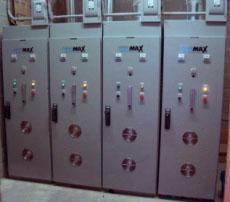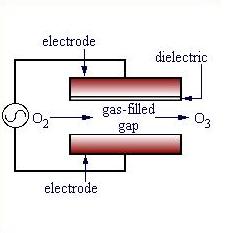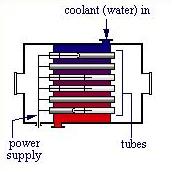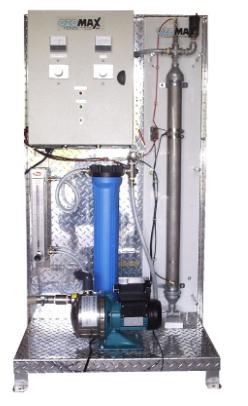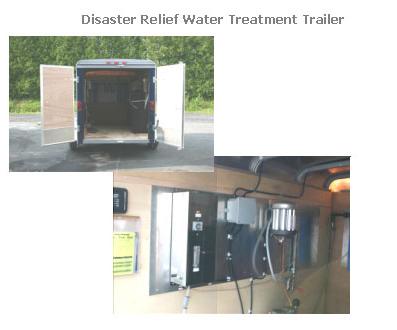Ozone (O3), produced from elemental oxygen in an Ozonator, is used for water treatment.
General Information
Ozone is a naturally occurring compound in the earth’s atmosphere. When ozone encounters some compounds, one oxygen atom breaks away, attaches itself to the compound, and oxidizes it. Ozone kills bacteria within a few seconds by cell lysing . In addition to breaking down organic matter, ozone breaks down odor-causing compounds.
Because of its tendency to break down quickly, ozone cannot be stored or transported, but must be generated on site by ozone generators, also called ozonators. Ozone is most commonly produced by electrical corona discharge or ultraviolet irradiation of dry air or oxygen. The ozone is then injected or diffused into the treatment stream.
Equipment Design
Corona discharge, the primary technique for ozone production, is the formation of ozone through electrical discharge in a process gas. Two electrodes are separated by a dielectric and a gas-filled gap. AC voltage is applied to the cell. The electrical discharge in the gas-filled gap creates free, energetic electrons that dissociate O molecules into oxygen atoms. These oxygen atoms are intermediates that then form ozone.
Ozone can be decomposed easily by heating, so temperature control of the process gas and heat removal is an important factor in ozone generator efficiency. The design that is usually adopted is an array of water-cooled tubular cells. The arrangement, shown on the left, is similar to a shell and tube heat exchanger with water as the cooling medium in the space between the tubes. The tubes, typically stainless steel, act as electrodes, with a glass tube dielectric. The inside surface of the glass dielectric is metalized, forming the second electrode. Gas flows through the tubes, and AC current is generated in the inner electrode by a metallic brush.
Ozone is naturally formed by the sun, hence ozone can be obtained by ultraviolet irradiation of air in an Ozonator, such as the one shown here. This causes oxygen to be dissociated into radicals, which form ozone just as in the corona discharge. This process produces a much lower volume and lower concentration of ozone than corona discharge.
The generating capacity of an Ozonator can be increased by enriching the air with oxygen or using pure oxygen. This is economically feasible only if the oxygen is recovered, so it’s seldom done.
For maximum efficiency, it is important that the entering air be dry since ozone decomposition is accelerated by moisture. In addition, water vapor will accelerate corrosion in the Ozonator.
Usage Examples
Ozonators are used mainly in wastewater treatment and water disinfection. Specifically, ozonators are ideal for decolorization, deodorization, disinfection, and oxidation. Pictured below are point-of-use ozonators that are used to treat water at one particular faucet in the home and can treat 0.5 – 1 GPM (2 – 4 L/min). The other type of water treatment system are point-of-entry ozonators, which treat water as it enters the home. These systems treat 1 – 10 GPM (4 – 40 L/min).
Ozone generators can also be used in larger applications such as industrial processes, municipal water treatment, and wastewater treatment. The system pictured below is used for disaster relief water treatment and is mounted on a trailer so that it can be transported to various sites.
Advantages
- Ozone is not considered a health hazard.
- A wider range of organisms is destroyed by ozone than by chlorine.
- Excellent removal of taste and odors.
- Rapid reactions.
Disadvantages
- In corona discharge, only about 10% of the energy supplied is used to make ozone.
- Ozone cannot be stored but must be generated on-site.
- Equipment and operating costs can be high.
Acknowledgements
- OZOMAX, Inc., Shefford, Quebec
References
- Chapsal, P. “Generation Systems: Trailigaz Ozone Generator Technology.” Ozonization Manual for Water and Wastewater Treatment. Ed. W.J. Masschelein. New York: John Wiley & Sons, 1982: 33-46. Print.
- Langlais, Bruno, David A. Reckhow, and Deborah R. Brink. (Eds.) Ozone in Water Treatment: Application and Engineering. Lewis Publishers, Inc., 1991: 100-109. print.
- Lorch, Watler. Handbook of Water Purification, 2nd ed. Chichester: Ellis Horwood Limited, 1987: 513-529. Print.
- Rosen, Harvey M. “Ozone Generation and its Relationship to the Economical Application of Ozone in Wastewater Treatment.” Ozone in Water and Wastewater Treatment. Ed. Francis L. Evans III. Ann Arbor Science Publishers, Inc., 1972: 101-122. Print.
Developers
- Melissa Schlosser
- Matthew Robertson
- Kelsey Kaplan


